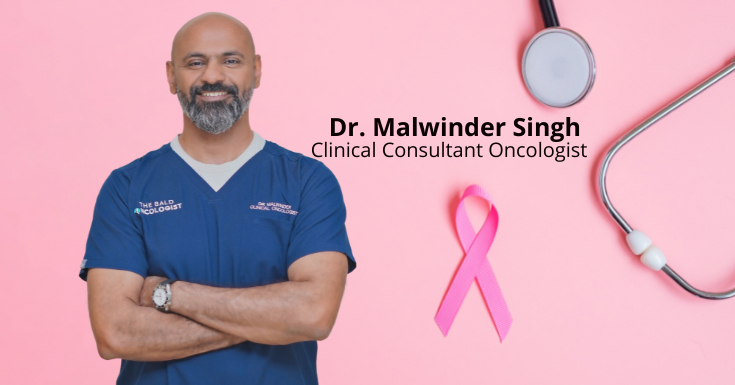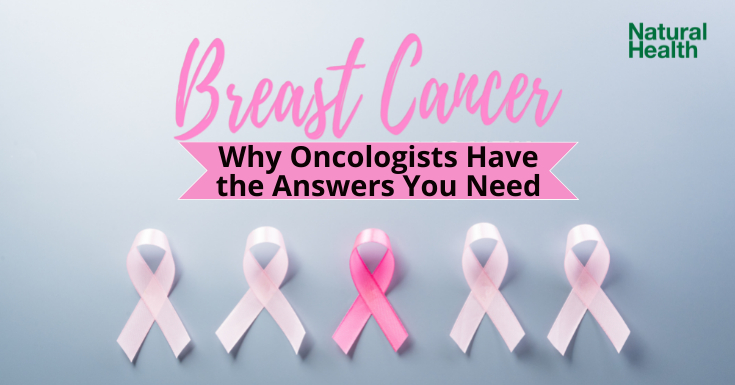Ever wondered why seeing an oncologist is crucial when facing a breast cancer diagnosis? Or if a lump always means early-stage breast cancer? In Malaysia, where late-stage diagnoses are common, oncologists provide more than just treatment plans—they offer personalized strategies, access to cutting-edge therapies, and essential support. Their expertise can make a huge difference in your recovery and overall well-being. Plus, they’ll share 6 recommended methods beyond self-examination for better detection. To know more, click in!
Breast cancer is the most common cancer among Malaysian women, with a troubling rate of 32.9% over the past four years, highlighting an urgent crisis. As World Breast Cancer Awareness Month draws attention to this issue, Dr. Malwinder, known as the Bald Oncologist, shares his perspective.
His journey into oncology began 15 years ago when he cared for a family member with cancer. This personal experience motivated him to become a clinical consultant oncologist, helping others navigate the complex world of cancer care. He emphasizes that seeing an oncologist for breast cancer is vital, especially in Malaysia, where early detection and specialized treatment can greatly improve outcomes. Here’s why:
- Accurate Diagnosis and Staging: Oncologists have the expertise to diagnose the specific type of breast cancer and determine its stage. In Malaysia, breast cancer often presents late, and an accurate diagnosis is essential for crafting an effective treatment plan.
- Personalized Treatment Plans: Breast cancer is not a one-size-fits-all disease. Oncologists provide tailored treatment, which may include surgery, chemotherapy, radiation, targeted therapy, immunotherapy or hormonal therapy. Factors like genetics, ethnicity, and even cultural considerations can influence treatment choices, and oncologists ensure that treatment aligns with individual patient needs.
- Access to the Latest Treatments and Technology: Specialized centers like Pantai Hospital Kuala Lumpur offer advanced treatments, such as targeted therapy, immunotherapy and Gamma Knife radiosurgery. Oncologists are trained to recommend cutting-edge treatments when appropriate, giving patients the best chance for recovery and quality of life. Even if certain new innovative drugs are not available in Malaysia, we can obtain them through import permits.
- Multidisciplinary Care: Breast cancer treatment often requires a team approach. Oncologists coordinate with surgeons, radiologists, and other specialists to provide comprehensive care. In Malaysia, multidisciplinary teams are increasingly common, and this collaboration improves patient outcomes.
- Emotional and Psychological Support: In Malaysia, where cultural norms may sometimes discourage open discussions about cancer, oncologists play a key role in addressing the emotional and psychological aspects of the disease. They help patients navigate not just the physical challenges, but also the mental and emotional toll of cancer.
- Surveillance and Follow-Up: After initial treatment, oncologists continue to monitor patients for any signs of recurrence. This long-term care is vital in a country like Malaysia, where late-stage diagnosis remains a challenge, and early recurrence detection can save lives.
Seeing an oncologist ensures that patients receive the best possible care from diagnosis through treatment and beyond, increasing their chances of survival and improving their quality of life. There are many innovative treatments that oncologists would know first hand and those options could provide convenience to patients enhancing their quality of life.
Does a Lump Indicate Early-Stage Breast Cancer?
The presence of a lump can be a sign of breast cancer, but it doesn’t always indicate early-stage cancer. In fact, many women in Malaysia present with lumps when the cancer has progressed to a more advanced stage. This is partly because the lump may be painless and women may not seek medical attention right away, or cultural stigmas and lack of awareness delay early screening. Therefore, while self-examination is important, it should not be relied on as the sole method of detection.
- Not Necessarily: A lump can be an early sign, but not always. Some lumps are benign, while others may indicate a more advanced stage of cancer, especially if they are accompanied by symptoms like skin changes, nipple discharge, or swelling. In Malaysia, many women might delay seeking medical advice due to fear or cultural beliefs, which means that by the time a lump is discovered, it could be more advanced.
- Importance of Medical Evaluation: Any new lump should be evaluated by a healthcare professional. Oncologists use imaging techniques to assess whether the lump is cancerous and what stage the cancer is in.
Recommended Methods Beyond Self-Examination
- Clinical Breast Examination (CBE):
- Why Important: A clinical breast examination by a trained healthcare professional can detect abnormalities that might be missed in a self-exam.
- Malaysia’s Context: Given the gaps in awareness, regular CBE is a vital tool. Women, especially those in rural areas, should be encouraged to attend healthcare centers for periodic exams.
- Mammography:
- Gold Standard: Mammograms are the most reliable method for early detection of breast cancer, especially for women over 40 or those at high risk. In Malaysia, the Ministry of Health recommends mammograms as part of routine screenings, but uptake remains low due to lack of awareness, cost, or fear.
- Programs like subsidized mammography are available in some public healthcare settings, and private hospitals offer these services with advanced technology for more precise screening.
- Ultrasound:
- Supplement to Mammography: Ultrasound is useful for women with dense breast tissue, which is common in younger women or women of certain ethnic groups, like the Malay and Chinese populations in Malaysia. It is often used in conjunction with a mammogram to detect abnormalities.
- Ultrasound can help distinguish between solid masses (which might be cancerous) and cysts (which are usually benign).
- MRI (Magnetic Resonance Imaging):
- For High-Risk Women: MRI is typically recommended for women with a higher risk of breast cancer, such as those with a family history or genetic predisposition (e.g., BRCA mutations). While it’s not used for routine screening, it offers a more detailed view for complex cases.
- Genetic Testing:
- For High-Risk Individuals: Women with a family history of breast cancer should consider genetic testing for BRCA mutations or other risk factors. This is still relatively uncommon in Malaysia but is gaining traction as awareness grows. If a woman tests positive, more frequent screening may be advised.
- Digital Tomosynthesis (3D Mammography):
- Latest Technology: Available in advanced healthcare settings, this method offers a 3D view of the breast, improving detection rates, especially in women with dense breast tissue.
From Discovery to Diagnosis: What to Do If You Find a Lump in Your Breast
If someone finds a lump in their breast, it’s important for them to take immediate action and follow these steps:
-
- Seek Professional Help Immediately:
- Don’t Wait: After discovering a lump, the first and most important step is to see a doctor without delay. It doesn’t necessarily mean cancer, but only a healthcare professional can evaluate and determine whether further testing is needed.
- Clinical Breast Examination (CBE):
- Thorough Evaluation: A clinical breast examination by a healthcare provider will help assess whether the lump is suspicious.
- Diagnostic Imaging:
- Mammogram or Ultrasound: If the doctor suspects something unusual, they will likely recommend a mammogram or ultrasound. This can provide detailed imaging of the breast and help determine whether the lump is solid (potentially cancerous) or a benign cyst.
- Access to Imaging: In urban areas like Kuala Lumpur, imaging tests like mammograms are widely available in private hospitals as well as in public hospitals. In rural areas, patients may need to travel to larger cities or district hospitals for these tests.
- Biopsy:
- Definitive Diagnosis: If imaging suggests the lump may be cancerous, a biopsy will be performed. This involves taking a small sample of the tissue to determine whether cancer cells are present. Biopsies are the gold standard for confirming a cancer diagnosis.
- Timely Referrals to Specialists:
- See an Oncologist or Breast Surgeon: Once a diagnosis is made, the next step is to consult with a breast surgeon or oncologist.
- Seek Professional Help Immediately:
Dr. Malwinder emphasizes that while self-examination is an important tool for breast awareness, it should be supplemented with clinical exams and advanced screening methods such as mammograms, ultrasounds, and, in certain cases, MRIs. In Malaysia, raising awareness about these screening options and improving access—especially in underserved communities—can play a crucial role in enhancing early detection and improving breast cancer outcomes. If you discover a lump, take immediate action—don’t wait! It doesn’t necessarily mean cancer, but only a healthcare professional can evaluate your condition and determine whether further testing is needed.




